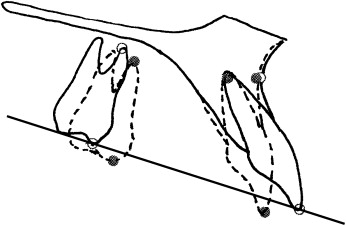Introduction
The objective of this pilot randomized clinical trial was to investigate the relative effectiveness of anchorage conservation of en-masse and 2-step retraction techniques during maximum anchorage treatment in patients with Angle Class I and Class II malocclusions.
Methods
Sixty-four growing subjects (25 boys, 39 girls; 10.2-15.9 years old) who required maximum anchorage were randomized to 2 treatment techniques: en-masse retraction (n = 32) and 2-step retraction (n = 32); the groups were stratified by sex and starting age. Each patient was treated by a full-time clinic instructor experienced in the use of both retraction techniques at the orthodontic clinic of Peking University School of Stomatology in China. All patients used headgear, and most had transpalatal appliances. Lateral cephalograms taken before treatment and at the end of treatment were used to evaluate treatment-associated changes. Differences in maxillary molar mesial displacement and maxillary incisor retraction were measured with the before and after treatment tracings superimposed on the anatomic best fit of the palatal structures. Differences in mesial displacement of the maxillary first molar were compared between the 2 treatment techniques, between sexes, and between different starting-age groups.
Results
Average mesial displacement of the maxillary first molar was slightly less in the en-masse group than in the 2-step group (mean, –0.36 mm; 95% CI, –1.42 to 0.71 mm). The average mesial displacement of the maxillary first molar for both treatment groups pooled (n = 63, because 1 patient was lost to follow-up) was 4.3 ± 2.1 mm (mean ± standard deviation). Boys had significantly more mesial displacement than girls (mean difference, 1.3 mm; P <0.03). Younger adolescents had significantly more mesial displacement than older adolescents (mean difference, 1.3 mm; P <0.02).
Conclusions
Average mesial displacement of the maxillary first molar with 2-step retraction was slightly greater than that for en-masse retraction, but the difference did not reach statistical significance. This finding appears to contradict the belief of many clinicians that 2-step canine retraction is more effective than en-masse retraction in preventing clinically meaningful anchorage loss.
Editor’s comment
When discussing the value of a randomized clinical trial (RCT), I often hear this comment: “The RCT designed in a university setting does not resemble real-world orthodontic treatment. Clinicians don’t treat entire groups of patients to a specific protocol for comparison with another group; we treat 1 patient at a time, making decisions at every appointment to achieve the best treatment result.” If you are one to keep an open mind, I believe you will like this RCT of 64 patients with Class I or II malocclusion and maximum anchorage requirements. After extracting either the first or second premolars, depending on the patient’s need, clinicians chose the most appropriate extraoral anchorage device for each patient, including a transpalatal arch for a boost in anchorage in some. In other words, the clinicians did what was most appropriate for each patient. The primary purpose of the study was to test whether there were statistically significant between-treatment differences in mesial displacement of the maxillary first molars when spaces were closed in 2 steps, by retracting the canines first and then the remaining anterior teeth, vs 1 step, by retracting all 6 anterior teeth as a single unit—the “en-masse retraction” approach. Was there a difference in anchorage loss between these approaches?
This is an important article for 2 reasons: first, because it is one of the few bona fide RCTs in orthodontics that deals with a real clinical question, and, second, because it represents a unique collaborative effort among 3 groups: a leading-edge statistician at the National Institutes of Health, a group of experienced clinical investigators at the Craniofacial Research Instrumentation Laboratory of the Arthur A. Dugoni School of Dentistry at the University of the Pacific, and an up-and-coming group of clinical orthodontists at the leading university in mainland China.
Before patient selection, a power calculation was conducted to determine the appropriate sample size; inclusion and exclusion criteria for all subjects were stated and adhered to. The subsamples were well balanced for sex, Angle class, starting age, and pretreatment crowding. At the start of treatment, latitude in making all treatment decisions for each patient was delegated to the treating clinician because these decisions were considered to be part of the clinician’s unique treatment plan for that patient. For more details, be sure to read the online version of this study.
Take home points:
- •
The findings demonstrate fairly conclusively that there was no statistically significant difference in mesial displacement of the maxillary first molar between the 2 samples.
- •
When the en-masse and 2-step treatment groups were pooled, the mean mesial displacement of the maxillary molars for the boys in the study was significantly greater than that for the girls.
- •
Patients of both sexes who started treatment before age 13 had significantly more mesial displacement of the maxillary first molar than patients who started treatment later.





